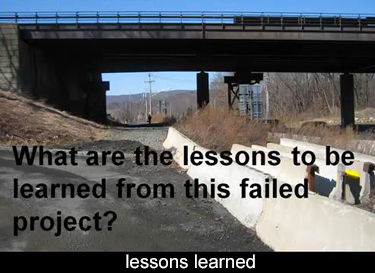At this point in the project, the north abutment has been constructed, that is to say, in so far as it could be constructed. In other words, because the existing bridge is in place overhead, you could not build the abutment to its full height. They completed the construction as far as they could go, and they've now moved to the south side of the bridge to construct the new south abutment.
The tool you see here is an auger. The auger is pre-drilling a line of holes for the h-piles, which will provide soldier pile and lagging support of excavation. The new abutment is going to be constructed where this auger is parked, but it's constructed in a very deep excavation, right alongside the existing temporary supports. The means of supporting the excavation is soldier piles and lagging, which of course we know is a very, very useful and effective support of excavation technique.
 However, in this case, it passes very close - in fact, somewhat undermines the existing temporary tower. Soldier piles and lagging is an excellent means of supporting excavation, but as we have learned in previous lectures, you cannot support a concentrated load using the various sheeting techniques. Here, we have the situation where a deep excavation is required. The means and methods are going to be soldier piles and lagging, but right behind the line of excavation. In fact, actually overhanging the line of excavation, is a concentrated load. You cannot proceed that way. It is unsafe to excavate that close to a concentrated load, and as we have learned, the concentrated load has to be underpinned or re supported, in some way before this excavation can take place.
However, in this case, it passes very close - in fact, somewhat undermines the existing temporary tower. Soldier piles and lagging is an excellent means of supporting excavation, but as we have learned in previous lectures, you cannot support a concentrated load using the various sheeting techniques. Here, we have the situation where a deep excavation is required. The means and methods are going to be soldier piles and lagging, but right behind the line of excavation. In fact, actually overhanging the line of excavation, is a concentrated load. You cannot proceed that way. It is unsafe to excavate that close to a concentrated load, and as we have learned, the concentrated load has to be underpinned or re supported, in some way before this excavation can take place.
The other option, when the temporary Tower was constructed, it could have been, and should have been constructed at an elevation much, much deeper at an elevation equal to the final elevation of the newly constructed abutment. That also would have been a safe procedure. There were two opportunities to avoid this close proximity, but neither of them was utilized. It’s not for me to judge who made the mistake or try to assign responsibilities. I can only say that shortly after I raised this issue with the people on the project, the construction was stopped.
 Here is the situation, today. The construction was halted, and eventually the construction contract was terminated. There was, to my knowledge, no finding of fault. The contractor was simply excused from the project. He was paid for whatever work he accomplished. It seems to me that there was a very clever initiative in trying to build this new abutment underneath the existing bridge, but because it was a departure from the norm, it gave rise to other problems - problems which perhaps the project people were not fully conversant with.
Here is the situation, today. The construction was halted, and eventually the construction contract was terminated. There was, to my knowledge, no finding of fault. The contractor was simply excused from the project. He was paid for whatever work he accomplished. It seems to me that there was a very clever initiative in trying to build this new abutment underneath the existing bridge, but because it was a departure from the norm, it gave rise to other problems - problems which perhaps the project people were not fully conversant with.
Therefore there was a series of errors. I would never suggest for a minute that people don't innovate and seek new solutions, but it is always important to have an awareness of constructability issues to be intimately familiar with the construction process. That kind of a background, I think, will help you avoid problems of this sort.